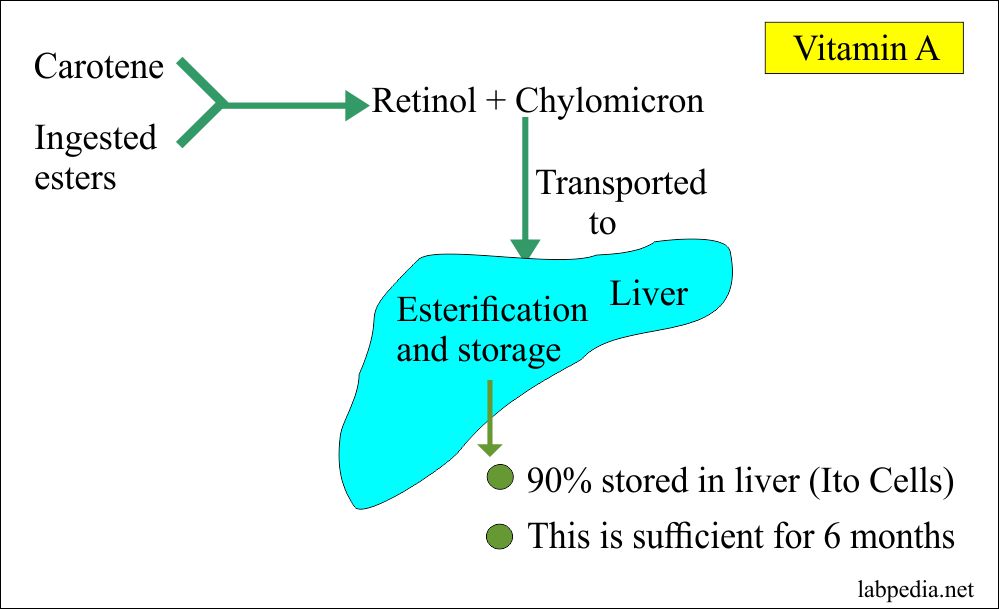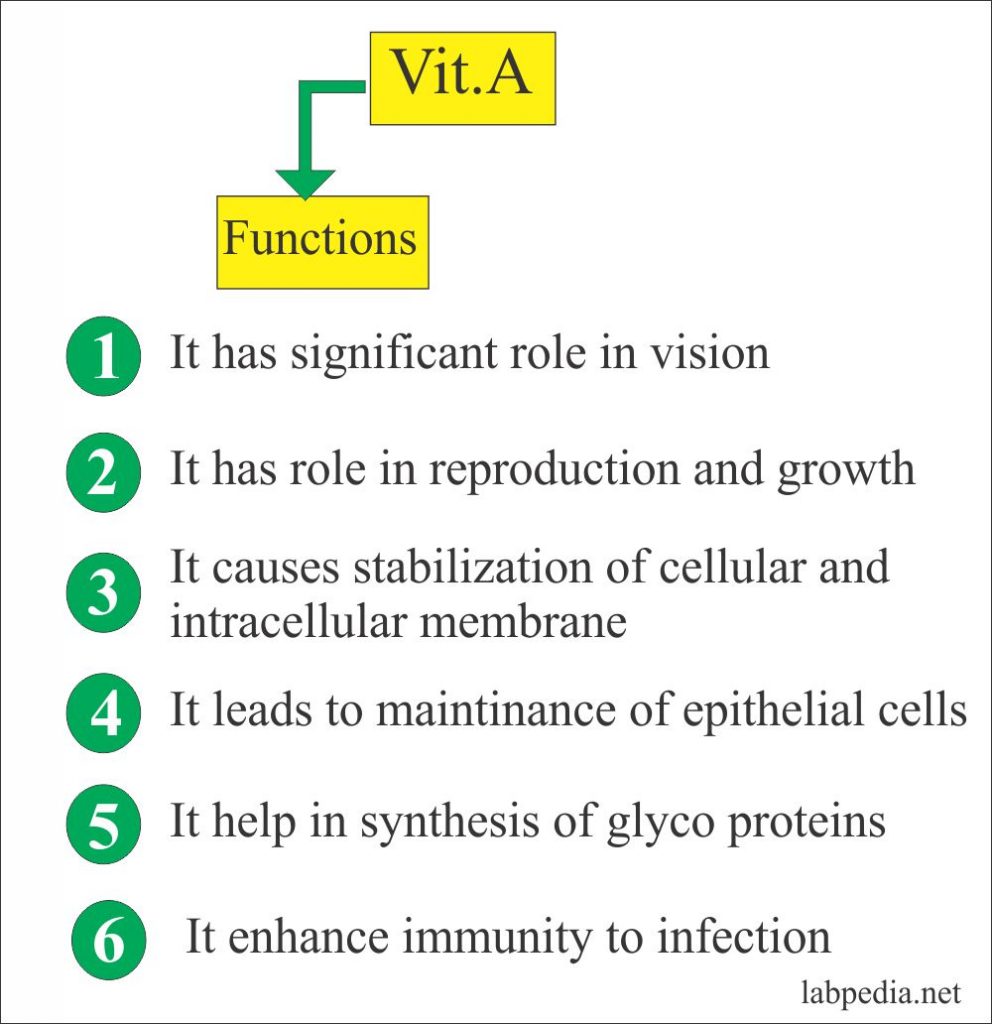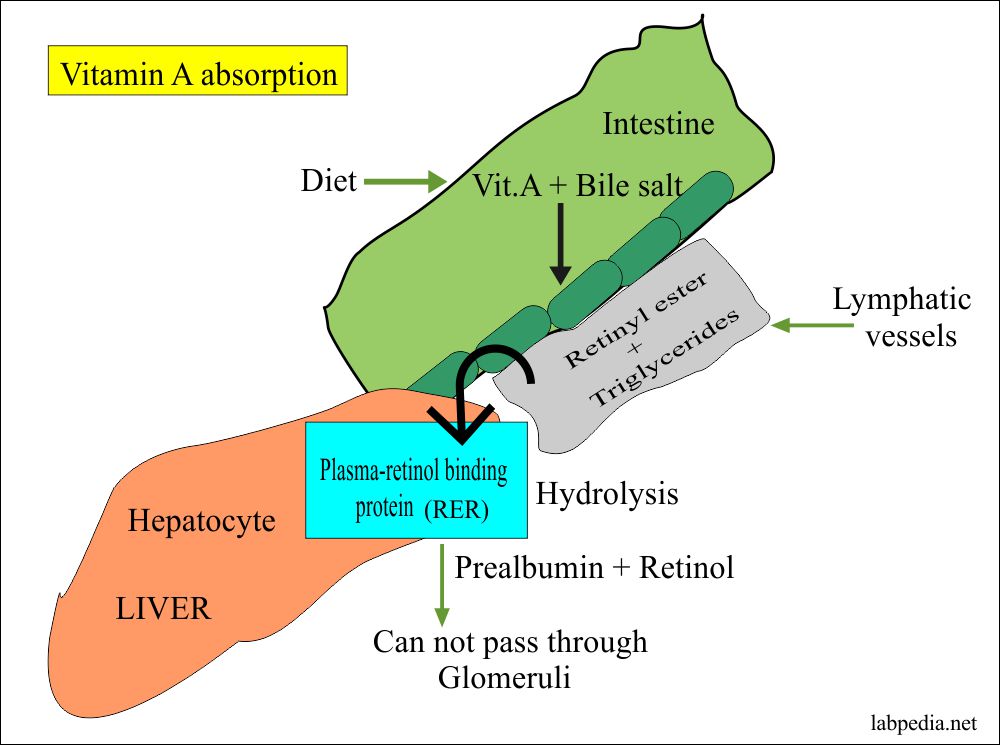Vitamin A (Retinol, Retinoid, and Carotenoid)
Sample
- Serum or plasma needed.
- A fasting sample is preferred.
- A fasting sample is preferred.
- The sample is stable for 4 weeks at 4 °C
Precaution
- Avoid hemolysis.
- Avoid sample from the light.
- Do not ingest alcohol 24 hours prior to the blood draw.
Definition Of Vitamins
- Vitamin name was given by a Polish Chemist, Casimir Funk. in 1991.
- He discovered that a nutrient that was able to cure the Beri Beri in pigeons.
- He suggested that it is amines present in food and it prevents diseases.
- He named it as vitamin = vita means life so he named these substances like vitamins.
- Vitamins are necessary for life.
- The deficiency of a single vitamin is usually uncommon.
- Vitamin deficiency may be due to an inborn error of metabolism or restricted diet intake.
- Vitamins are needed in µg or mg per day for the normal metabolic function of the body.
- These may be water-soluble or fat-soluble.
- Fat-soluble vitamins are:
- Vit. A
- Vit. D
- Vit.E
- Vit. K
- These are stored for a longer time.
- These vitamins don’t function as coenzymes.
- Water-soluble vitamins are:
- Vit B complex
- Vit. C
- Lost for a short time.
- These function as coenzymes for numerous important enzymatic reactions.
Vitamin A (Retinol; Retinoic acid; Carotenoids)
- Vitamin A is an essential nutrient.
- Vitamin A is found in:
- Diet rich in retinyl esters.
- Metabolism of carotenoids, provitamin A and it is primarily β-carotene.
- Diet sources are:
- Animal products.
- Pigmented fruits.
- Vegetables (carotenoids).
- Vitamin A is stored in the liver and in the blood circulation is bound to retinol-binding protein and transthyretin.
- Functions: Vitamin A helps, form, and maintain healthy skin, teeth, skeletal and soft tissue, mucous membranes, and skin.
- It is needed for good vision.
- Needed for the growth of fetus and embryo (reproduction and growth).
- It has a role in the immune system.
- It helps in wound healing.
- It helps in growth.
- It helps in the reproductive system.
- Vit. A is sensitive to oxygen and ultraviolet light.
- Vit. A exists in three forms:
- Retinol (A1) is the most important form of Vit.A.
- This is the transport form as the Retinol ester and also storage form.
- This is oxidized to aldehyde retinal which is used in visual pigments.
- Also oxidized to retinoic acid.
- Retinal.
- Retinoic acid.
- Retinoids are both natural and synthetic chemicals that are structurally similar to Vit. A but don’t have the function like vit.A.
- These are derived from the dietary source mainly carotenoids.
- It is insoluble in water and soluble in organic solvents and mineral oil.
- Vit. A is sensitive to oxygen and ultraviolet light.
- It is also known as retinol because it produces the pigments in the retina of the eye.
- Vitamin A and provitamin A are absorbed in the presence of bile salts.
- These are taken up by the small intestine epithelial cells.
Role of Vitamin A in the eye:
Deficiency Leads:
- To degeneration of eyes and skin.
- There may be Vit. A deficiency night blindness (nyctalopia).
- When the deficiency is prolonged then the patient may have total blindness.
- The patient may have Dry eyes (Xerophthalmia).
- There is dryness of the conjunctiva (xerosis conjunctivae).
- There are Bitot spots.
- There are keratomalacia and ultimately blindness.
- Sometimes patients develop diarrhea.
- The patient may develop skin problems.
- There are metaplastic changes in the epithelium of the lungs (squamous metaplasia).
- Metaplasia is the urinary tract that leads to stone formation.
- The patient develops an immune deficiency.
- Common infections like measles, pneumonia, and diarrhea are very serious in these patients.
- Recurrent infections.
- There is a retardation of growth.
- There is an abnormal taste.
- Summary of Vitamin A is essential for vision, cellular differentiation, growth, reproduction, and immune system function.
- Deficiency of Vitamin A is caused by:
- Chronic fat malabsorption.
- Impaired liver function.
- Severe stress.
- Protein malnutrition.
- Premature babies are born with a deficiency of retinol and retinol-binding protein.
Dietary Sources Are:
- Eggs.
- Fish liver oil.
- Dairy products like milk, yogurt, cheese, and butter.
- Meat includes beef, chicken liver, and calf.
- Vit. A1 is present in the liver of mammals and saltwater fish.
- Vit. A2 is found in the freshwater fish oils.
- Vegetables like carrots, squash, and spinach. Fruits and vegetables contain carotene which is the precursor of the retinol.
Overdosage Side Effects Are:
- This can lead to liver failure.
- The patient may develop headaches, fatigue, and muscle joint pains.
- The Patient skin is dry.
- The patient may develop nausea and diarrhea.
- There is hair loss.
- Chronic toxicity leads to weight loss, nausea, and vomiting.
Normal
Source 1
| Age | µg/dL |
| 1 to 6 years | 20 to 43 |
| 7 to 12 years | 26 to 49 |
| 13 to 19 years | 26 to 72 |
| Adult | 30 to 80 |
Other sources
- Daily requirements are:
- Infants (average intake)
- 1 to 6 months: 400 µg per day.
- 7 to 12 months: 500 µg/day
- Children (RDA)
- 1 to 3 years: 300 µg/day
- 4 to 8 years: 400 µg/day
- 9 to 13 years: 600 µg/day
- Adolescents and Adults (RDA)
- Males age 14 and older: 900 µg/day
- Females age 14 and older: 700 µg /day
- Or 65 to 275 I.U / 100 ml.
- Or > 20 µg / 100 ml.
- From other reference normal values for Vitamin A (Retinol) in the serum:
- 1 to 6 years = 20 to 43 µg/dL.
- 7 to 12 years = 26 to 49 µg/dL.
- Adults = 30 to 80 µg/dL.
- Severe deficiency = <10 µg/dL.
- Increased Vitamin A (hypervitaminosis) = >100 to 2000 µg/dL.
- Another source
- Recommended allowance of vitamin A:
- Adult male = 1000 µg/say.
- Adult female = 800 µg/say.
Carotene
Carotene is a precursor of vitamin A.
- 100 to 300 I.U / 100 ml or 40 to 300 µg/ 100 ml.
- Increased Carotene (Carotonemia) = > 250 µg/dL.












0 Comments